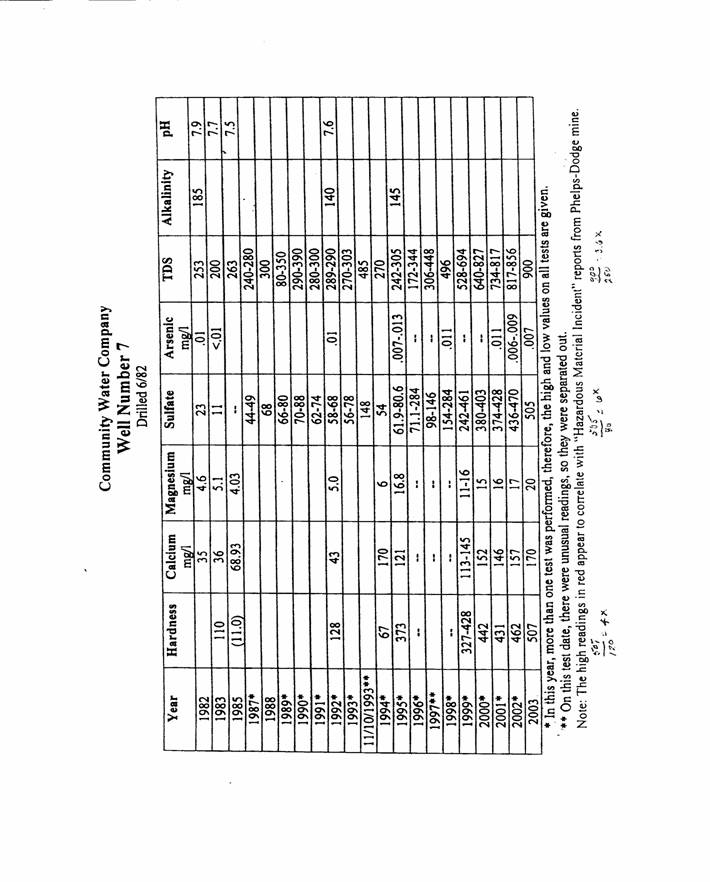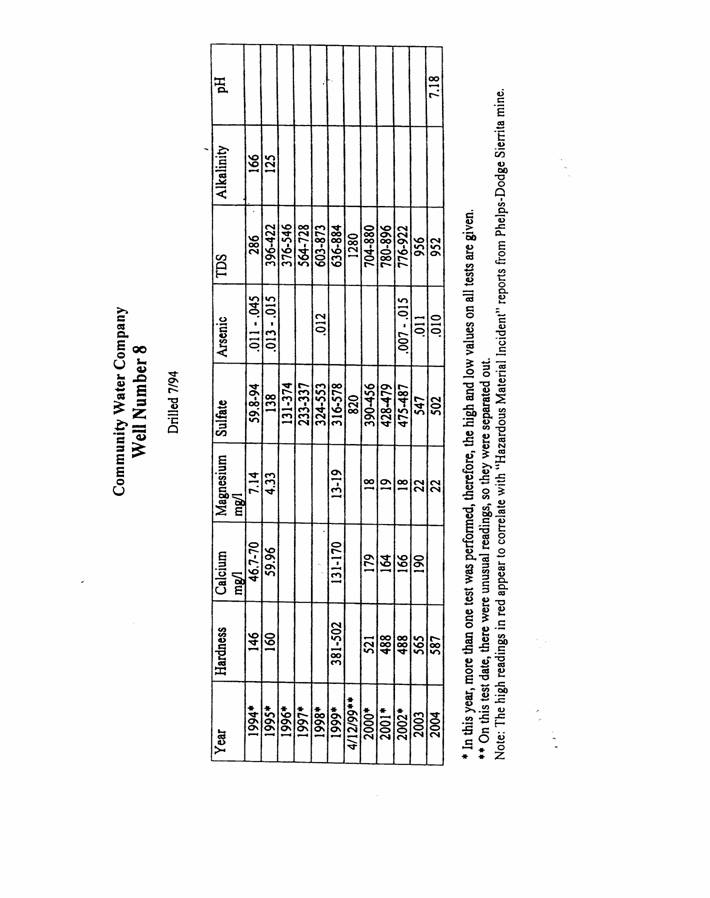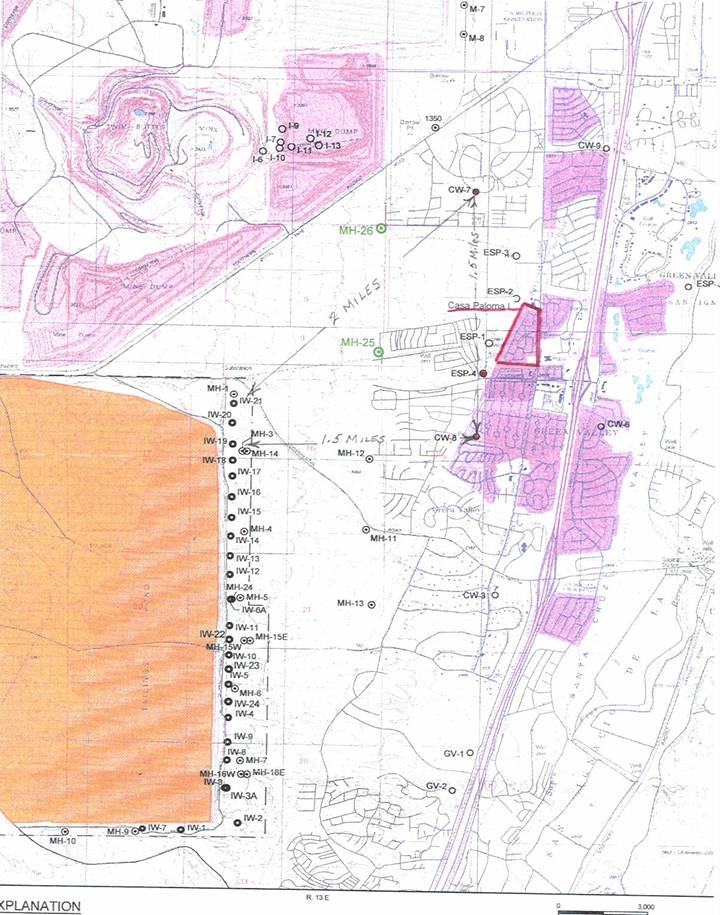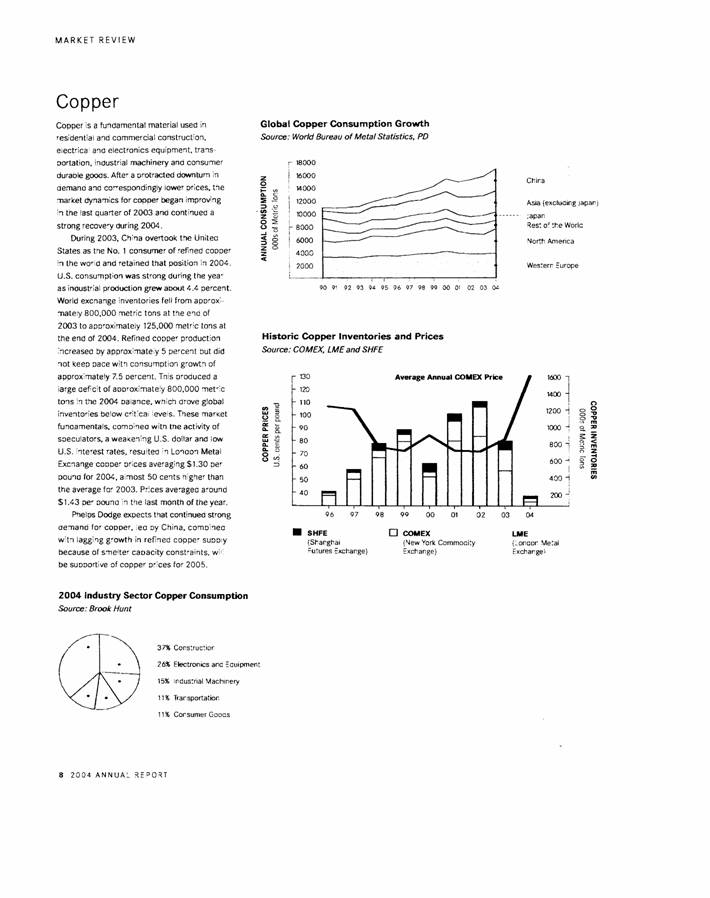Casa Paloma I Homeowners, Inc.
P. O. Box 411
Green Valley , AZ 85622
HEARING COMMENTS – AUGUST 17, 2005
Casa Paloma I Homeowners Association, Inc. (CPI) is submitting these comments to ADEQ regarding the Aquifer Protection Permit P-101679 (APP) that is under consideration for Phelps Dodge Sierrita, Inc. (PDSI), and requests that they become part of the record.
Organization of These Comments
- SHORT RESPONSE TO AQUIFER PROTECTION PERMIT P-101679 (APP)
- Description of Community Problem
- Adverse Health Effects
- Geography
- Casa Paloma I Statement of Interest
- Water Balance
- Interim Measures
- Long Range Measures
- Phelps Dodge Policy of Commitment
- Financial Considerations on Phelp Dodge Operations
- Radiochemicals
- Notification and Communication
A. SHORT RESPONSE TO AQUIFER PROTECTION PERMIT P-101679 (APP)
Phelps Dodge Sierrita, Inc. (PDSI)
A disconnect exists between what CPI and vast majority of Green Valley wants and what ADEQ is proposing in their draft APP. This disconnect makes the draft APP completely unacceptable.
What do Green Valley water users expect from their Aquifer?
We want and expect drinking water from the aquifer, now and in the future, at the higher quality ambient levels we were experiencing before the contamination from PDSI Tailing Impoundment seepage. The ambient was nominally 50 mg/l sulfate with associated TDS of 200 mg/l. in the 1980’s (ambient level).
What is ADEQ proposing in the APP?
Only two limits are being set for sulfates, both far inferior to our wants, and no better (and worse) than the unacceptable water quality that caused the shutting down of Community Water Company (CWC) wells 7 & 8. A User Protection Level (UPL) of 400 mg/l (which may be modified to 450-525) is proposed for ESP-4 (one of four PDSI Esperanza wells, three of which are the temporary sources of CWC water replacing wells 7 & 8), An Alert Level (AL) of 650 mg/l is proposed for CW-8 as a Point of Compliance (POC) well, which exceeds the levels experienced by CWC in years past.
Two conclusions can be made regarding these limits:
- They can be considered a license for PDSI to allow current and past conditions to continue. (It is unlikely that these limits will be exceeded in the next year or so, and only after the aquifer contamination has further degraded and spread)
- They allow ESP-4, and the current temporary sources of CWC water, to degrade to 400-525 mg/l which is completely unacceptable to the Green Valley water users (This is the level that caused the shut down of wells 7 & 8 in 2005). The UPL should be set at ambient with AL of twice ambient.
What is acceptable?
- The present condition of the aquifer is unacceptable, and ADEQ should be proactive in finding remedies to stop the degradation and spread of contamination before it reaches other well (or potential well) locations.
- We expect POC locations prescribed at the perimeter of the contaminated area (plume) with limits for sulfate at or near the ambient level, and AL set no higher than twice the ambient level. We believe this is necessary to stop further degradation now.
- We expect compliance schedules and contingency plans which will assure that contamination will not spread and will preserve unaffected areas at ambient levels for the future.
B. Description of Community Problem
Contamination and further degradation of the Santa Cruz aquifer by Phelps Dodge Sierrita, Inc. (PDSI) must be stopped now.
A plume of highly contaminated water from the PDSI mine tailing ponds has already contaminated two wells of the Green Valley Community Water Company (CWC). The water company has been delivering this contaminated water to our homes in Casa Paloma I for several years causing many anecdotal health problems as well as forcing additional costs on homeowners to buy bottled water or expensive home purification systems.
We are requesting that discharge limitations and compliance schedules be established to return the aquifer, particularly the Sulfate and TDS levels, to the ambient levels as evidenced on the measurements at Community Water Company wells Number 7 and 8, tabulation sheets (Attachment I ). These are the wells that are impacting our Casa Paloma I HOA members because of our proximity to them.
The Community Water Company is shutting down the two most contaminated wells, Nos. 7 & 8, made possible by temporary ties to other wells owned by PDSI. This will offer some temporary relief, but is no permanent solution to the problems facing Green Valley residents.
The permanent solution to the problem is for PDSI to step up to the problem and stop the contamination, either by preventative actions or by treatment of the contaminated plume they are producing. Failure to do this will result in further spreading of contamination into the Santa Cruz Aquifer due to the excessive levels of Sulfates and total dissolved solids (TDS).
C. Adverse Health Effects
Adverse health effects from sulfate should not be ignored before studies are made in an aging sub-population such as Green Valley.
Although government agencies consider sulfates non-toxic, they do recognize that sulfate may cause adverse health effects. Sulfate has a laxative effect in higher doses, but adverse health effects are usually temporary and recovery is rapid in the general population.
However, insufficient studies have been made in sub-populations such as the elderly. Anecdotal health problems have been reported in Green Valley, which are relieved upon switching to purified water. Green Valley has a population averaging over 70 years of age, and many have intestinal or other conditions that may result in adverse health effects (such as irritable bowel syndrome).
D. Geography
CWC wells Nos. 7 & 8 are approximately 1 ½ miles apart, and are located approximately 2 and 1 ½ miles respectively east of PDSI property line and interceptor wells (See Attachment II Diagram). Casa Paloma I is located between the pumps and slightly east. It is not known how much further the contamination has reached in the aquifer. (ADEQ reports six square miles in the APP FACT SHEET).
E. Casa Paloma I Statement of Interest
- CP I has a short-term interest in receiving quality water from Community Water Company similar to ambient quality (primarily in sulfates and TDS).
- CPI does not want higher water costs due to corrective measures necessary because of contamination from PDSI (costs should be borne by PDSI).
- CPI wants PDSI to step up and correct the problem of contaminating the Santa Cruz aquifer in the long term.
F. Water Balance
The APP should require PDSI to perform a Water Balance of their operation.
Phelps Dodge has recognized publicly that contamination of the aquifer is from the Tailings Impoundment. The amount and extent of damage to the aquifer is not known. A water balance of all liquids involved in the Tailings operation is needed to quantify this challenge, as well as tests and analysis of the affected areas. The contamination has reached public water supplies and future water supplies are threatened. The public has a right to know the results of tests and analysis that PD has obviously done in the course of a reasonable business approach to this challenge.
Water balance studies and monitoring must include all of the contaminated areas so that control technologies are effective in their design and implementation.
Example of Need for Water Balance
- In discussion with Mike Wood of Sierrita, total water utilized in their closed system is approximately 22,000 gpm, with about 1/3 from the interceptor wells (7300 gpm) and 2/3 from the fresh water wells (14,600 gpm). What happens to this 14,600 gpm? A water balance will indicate how much is consumed by evaporation and processes, and any water not accounted for may be assumed as seepage into the aquifer,
- How much seepage reached CWC wells Nos. 7 & 8 during years of operation? If these two wells pumped about one-half of CWC requirements for many years at 500 mg/l sulfate with an ambient condition of 50 mg/l, the volume of seepage reaching the pumps can be calculated. Likewise, the volume of seepage reaching the Interceptor wells can be calculated. (See Attachment III, Water Balance example). How does this pumped seepage correlate with the water balance seepage? Seepage water unaccounted for can be assumed to accumulate in the aquifer to threaten future water supplies.
- The large volume of seepage pumped out of the aquifer and delivered to CWC customers essentially converted CWC pumps into interceptor wells. What was the ultimate destination of these contaminated waters? They should be considered groundwater redirected to a river requiring an AZPDES permit?
- What will become of the contaminated water no longer being pumped by CWC wells Nos. 7 & 8? Will it migrate into the aquifer more rapidly and result in further degradation? (Several square miles are already contaminated underlying populated communities including CPI).
- It is the responsibility of ADEQ to investigate and flesh out the skeleton contained in these examples. It is the responsibility of PDSI to provide the necessary facts and figures and to make them known to the public.
G. Interim Measures
The contamination problem is not fully understood by PD at this time. We are thankful that PD interconnected unaffected pumps owned by them to the CWC system so that CWC contaminated wells Nos. 7 & 8 could be shut down, returning the system to ambient quality water again. This is only a short-term measure.
H. Long Range Measures
I personally spoke to John Brack, General Manager, PHELPS DODGE SIERRITA INC., and was pleased to hear that his goal is to complete studies, planning and implementation of a long term solution in 1 to 1½ years. I do not believe this is good enough and that studies should be accelerated. We need a timetable to achieve and demonstrate measurable results that will protect our aquifer now.
I. Phelps Dodge Policy of Commitment ( from phelpsdodge.com web site)
Stakeholder Engagement Statements
We’re striving to become more engaged in helping our communities develop long-term plans, programs and solutions that help keep them viable and plan for their future, regardless of the economic state of our business and industry.
We also realize that we must provide avenues for our communities to receive straightforward information about our operations and their activities. We want them to be able to voice their views so we can be responsive to their questions and concerns.
Our Management Philosophy
The Resource Management Department believes in and promotes sustainability, honesty, and integrity as we increase shareholder value and work to secure a prosperous future. Sustainability is a measure of the social, economic and environmental performance of our mining and industrial operations.
As a matter of common practice, the Resource Management Department focuses on working cooperatively with local communities to achieve reasonable and responsible approaches to the management of natural resources.
Leadership and Collaboration
An important part of our success is collaboration with stakeholders. We strive to foster open communication with our communities, consider their needs and concerns, and work together to develop thoughtful solutions.
Our involvement with our communities means more than just financial contributions or investments. Our goal is to be a leader in our communities, creating collaboration among multiple partner organizations and serving as a catalyst for positive change.
At times in our history this has been a challenge, and we have learned important lessons that have helped us improve and increase positive engagement and collaboration with community stakeholders.
J. Cost Considerations on Phelp Dodge Operations
2004 Annual Report Statement
To Our Shareholders,
During 2004, Phelps Dodge Corporation reaped the benefits of robust demand for copper and molybdenum, a disciplined approach to business, and the hard work and dedication of our 14,000 employees worldwide.
Page 8 in 2004 ANNUAL REPORT) shows copper prices at record highs, and world inventories at record lows (See Attachment IV). These are conditions of sufficient prosperity to fund control measures, as expensive as they may be.
K. Radiochemicals
Riadiochemical testing should be required in all monitor and user wells east of the Tailings Impoundment to assure that they do not reach and degrade user water supplies.
Monitor wells at the foot of the Impoundment Dam test high in sulfates and also high in Radiochemicals (Montgomery & Assoc. Lab report dated 12 Oct 2004 show MH-14, 15W and 16W with Gross Alpha activity up to 130 pCi/l compared to MCL limit of 15 pCi/l), and the APP requires biennial testing of these wells (See Attachment V).
However the APP has no quarterly or biennial testing requirements for Gross Alpha activity or sulfate for MH 11 and MH 12 that are located several thousand feet east (approximately halfway to CW-8). It seems reasonable to expect that the high sulfate/Gross Alpha near the dam is capable of migrating to these high-sulfate wells, and also to user water wells.
L. Notification and Communication
We consider ADEQ to be the state agency to serve our community and protect our water aquifer, and the APP is for that purpose. Beyond that, there are other players that have a vital interest in the ultimate solution of this problem.
Nothing in the APP addresses how to include these players. The APP is a document involving only two players, ADEQ and PDSI. Notification and communication procedures are needed to involve the other players.
The players are GVCCC, ADEQ, PDSI, CWC, CPI and other parties interested and involved in the water problem. It would be highly desirable to establish a “Water Protection” committee comprised of these players to present, review, and disseminate information to the public regarding problems and problem solving.
To be involved the Green Valley community needs to know what is going on. This means we must be notified, informed and be able to communicate.
Lacking such a committee or function, it will be necessary to establish very close communications with ADEQ. What will we need from ADEQ?
- Notification of all reports and correspondence received from PDSI (or directed to them).
- Notification of all meetings with PDSI so that we can attend as observers.
- Availability of all PDSI documents for review, preferably in Tucson or Green Valley (possibly at PDSI offices?).
- An avenue or procedure to query PDSI for information and to receive it.
- Public information meetings by ADEQ to monitor developments and progress.
It would be far better to have interactive meetings among the players with the cooperation and compromise needed for problem solving, and the establishment of trust. If PDSI decides to live up to their public statements quoted on Page 4 of these comments, this should be readily possible.
What are questions that need to be addressed?
- What is the definition of the contaminated area impacted?
- How much seepage is not being captured by interceptor pumps and is escaping into the aquifer? (A water balance may help to determine this).
- How can the escape of seepage be stopped?
- How can we know that there will be no more degradation of the aquifer?
- Why not set sulfate limits and Points of Compliance at the perimeter of the plume so that we can know if and when the ambient is being further degraded and contingency actions taken to stop it?
- How can the plume be stopped, mitigated or reversed?
- Is PDSI committed to addressing and solving the problem in good faith and good time?
Submitted by:
Dick Shuman, PE
Casa Paloma I Homeowners, Inc.
Environmental Coordinator
Ph: (520) 648-0445 Email shumans2@cox.net
ATTACHMENT I (A) CW - 7

ATTACHMENT I (B) CW - 8

ATTACHMENT II

ATTACHMENT III - WATER BALANCE
The public wants to know how much Tailings seepage is going into the aquifer without being intercepted and captured. This can be estimated by a water balance using the following three (or similar) steps.
1. How much seepage is leaving the Tailings Impoundment dam?
The make-up water pumped into PDSI property less evaporation and process usage, can be assumed to be seepage. (PDSI is a zero discharge facility).
2. How much seepage volume is being intercepted by PDSI Interceptor wells?
The seepage volume (Vs) intercepted by the Interceptor wells can be calculated by determining the volume pumped (Viw), the concentration of the water pumped and returned (I), and the concentration of the seepage underlying (leaving) the Tailing Impoundment (S) (see below).
3. How much seepage is not being intercepted and is contaminating and spreading in the aquifer?
The seepage from 1. above, minus the seepage from 2. above can be assumed to be the seepage not being intercepted, thereby contaminating and spreading in the aquifer.
Example : How much seepage volume is being intercepted by PDSI Interceptor wells?
(All figures are arbitrary for the sake of illustration)
A=Ambient sulfate mg/l Va= ambient volume gpm 1 US gallon = 3.7854118 liters
S=Seepage sulfate mg/l Vs= seepage volume gpm
I = Interceptor sulfate mg/l Viw= Interceptor well volume gpm
A*Va + S*Vs = I*Viw
When Va + Vs = Viw = 1, then Va = 1- Vs and Vs = 1 – Va
Va = (S – I) and Vs = (I – A)
(S – A) (S – A)
If A=50, S=1250, I=500 then
Va = 0.625 Vs = 0.375 or Va = 62.5% and Vs = 37.5% of the water pumped (Viw) from Interceptor wells.
If Interceptor wells are pumping 7300, gpm, then 2737 gpm (37.5 %) seepage is being captured.
Before 2005, the CWC wells 7&8 were pumping about half of CWC water supply. How much seepage reached CWC wells Nos. 7 & 8 during years of operation? If these two wells pumped about one-half of CWC requirements for many years at 500 mg/l sulfate with an ambient condition of 50 mg/l, the volume of seepage reaching the pumps can be calculated (As shown below) and can also be subtracted to arrive at an estimate of seepage not being intercepted and contaminating and spreading in the aquifer.
4. The large volume of seepage pumped out of the aquifer and delivered to CWC customers essentially converted CWC pumps into interceptor wells. What was the ultimate destination of these contaminated waters? They should be considered groundwater redirected to a river requiring an AZPDES permit?
What will become of the contaminated water no longer being pumped by CWC wells Nos. 7 & 8? Will it migrate into the aquifer more rapidly and result in further degradation? (Several square miles are already contaminated underlying populated communities including CPI).
5. It is the responsibility of ADEQ to investigate and flesh out the skeleton contained in these examples. It is the responsibility of PDSI to provide the necessary facts and figures and to make them known to the public.
A=Ambient sulfate mg/l Va= ambient volume gpm 1 US gallon = 3.7854118 liters
S=Seepage sulfate mg/l Vs= seepage volume gpm
C= CWC sulfate mg/l Vc= CWC volume gpm
A*Va + S*Vs = C*Vc
When Va + Vs = Vc = 1, then Va = 1- Vs and Vs = 1 – Va
Va = (S – C) and Vs = (C – A)
(S – A) (S – A)
If A=50, S=1250, C=500 then
Va = 0.625 Vs = 0.375 or Va = 62.5% and Vs = 37.5% of the water pumped (Vc) from #7 & 8.
If CWC wells 7&8 were pumping 2000 gpm, then 750 gpm (37.5 %) seepage was being captured.
ATTACHMENT IV

ATTACHMENT V
Radiohemicals Suumary from APP and Montgomery & Assoc Lab report 12Oct2004
MCL limits AQL AL
Limits for Gross Alpha 15 pCi/L 12 pCi/L (These are the same limits
Limits for Radium 5 pCi/L 4 pCi/L used in the APP)
Biennial Testing is Required in APP for Radiochemicals for these wells (although quarterly testing is required for other components).
Range of test results
LAB Tests Gross Alpha Radium
MH 14 18-29 ok (within limits)
MH 15W 20-130 ok
MH 16 W 4-130 ok
MH 18 4-25 ok
MH 19 5-32 ok
MH 20 ok (within limits) ok
MH 21 406-1090 11-21
MH 22 38-282 ok
MH 23 14-188 ok
MH 27 No Lab Report
MH28 No Lab Report
MH 29 No Lab Report
Radiochemicals testing is not required in the APP for these “Non-hazardous” wells ( although they are tested Quarterly for other components).
LAB Tests Gross Alpha Radium
MH 11 ok ok
MH 12 ok ok
MH 25A ok ok
MH 26 A ok ok
CW-8 No Lab report
These wells are not listed in APP tables but were tested for Radiochemicals in the Lab report.
Range of test results
LAB Tests Gross Alpha Radium
MH 17 69-170 15-149
MH 18 4-22 ok
MH 19 8-32 ok
Note: All lab reports on PZ-1 to PZ –16 are exceeding Gross Alpha limits and six of them exceeded the Radium limits.
Dick Shuman
July 28, 2005
Riadiochemical testing should be required in all monitor and user wells east of the Tailings Impoundment to assure that they do not reach and degrade user water supplies.
Monitor wells at the foot of the Impoundment Dam test high in sulfates and also high in Radiochemicals (Montgomery & Assoc. Lab report dated 12 Oct 2004 show MH-14, 15W and 16W with Gross Alpha activity up to 130 pCi/l compared to MCL limit of 15 pCi/l), and the APP requires biennial testing of these wells (See Attachment V).
However the APP has no quarterly or biennial testing requirements for Gross Alpha activity or sulfate for MH 11 and MH 12 that are located several thousand feet east (approximately halfway to CW-8). It seems reasonable to expect that the high sulfate/Gross Alpha near the dam is capable of migrating to these high-sulfate wells, and also to user water wells.
Below is from my Oral statement I submitted in writing at the Hearing
Radiochemical
Riadiochemical testing should be required in all monitor and user wells east of the Tailings Impoundment to assure that they do not reach and degrade user water supplies.
Monitor wells at the foot of the Impoundment Dam test high in sulfates and also high in Radiochemicals. Tests on several of the monitor wells at the foot of the Impoundment dam are many times higher in Gross Alpha activity than the maximum EPA limits for drinking water,
However the APP has no testing requirements for monitor wells that are located several thousand feet east approximately halfway to drinking water wells. It seems reasonable to expect that Radiochemicals near the dam are capable of migrating to these high-sulfate wells, and also to user water wells.
Radiochemicals This is from my SPEAKING text at the Hearing.
Riadiochemical testing should be required in all monitor and user wells east of the Tailings Impoundment to assure that they do not reach and degrade user water supplies.
Monitor wells at the foot of the Impoundment Dam test high in sulfates and also high in Radiochemicals. They test 10 times higher than the Alarm Levels set in the permit and by the EPA for Gross Alpha activity. This is bad because when ingested it can seek lungs and bones causing cancer.
However the Permit has no testing requirements for monitor wells that are located several thousand feet east, approximately halfway to drinking water wells. It seems reasonable to expect that Radiochemicals near the dam are capable of migrating to these high-sulfate wells, and also to user water wells.